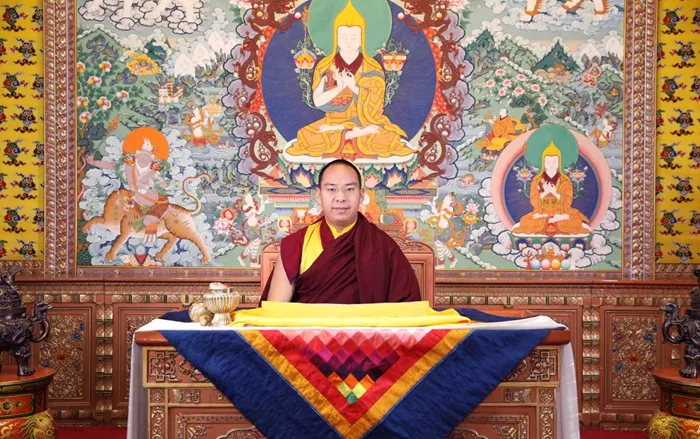The Panchen Lama is one of the most important spiritual leaders in Tibetan Buddhism. Alongside the Dalai Lama, the Panchen Lama holds a very high position in the Gelug school, which is the largest school of Tibetan Buddhism. The word “Panchen” means “Great Scholar,” which shows the Lama’s deep knowledge of Buddhist teachings.
Why is the Panchen Lama important?
The Panchen Lama is seen as a spiritual guide and a teacher. He is believed to be an incarnation of Amitabha Buddha, who represents compassion and wisdom. The Panchen Lama helps preserve the teachings of the Buddha and plays a key role in recognizing the next Dalai Lama. Their relationship is special and linked by tradition.
The Historical Background of the Panchen Lama
Origins and early history
The title of Panchen Lama started in the 17th century. The first person called Panchen Lama was Lobsang Chökyi Gyaltsen (1570–1662). However, it was after his death that he was recognized as the first Panchen Lama. The title was given by the Fifth Dalai Lama, showing respect and recognition for his wisdom and spiritual achievement.
Development over time
Over the centuries, the Panchen Lamas became spiritual leaders with strong influence in Tibet. They lived mostly in Tashilhunpo Monastery in Shigatse, the second-largest city in Tibet. The Panchen Lama and the Dalai Lama worked together to guide Tibetan Buddhists and maintain peace and religious harmony.
The Panchen Lama during Chinese rule
Since the 1950s, Tibet has been under Chinese control, which changed many religious and political structures. The Panchen Lama’s role became complicated during this time. The Chinese government has taken part in selecting the Panchen Lama, leading to controversies and tensions with Tibetan Buddhists and supporters of the Dalai Lama.
The Role of the Panchen Lama in Tibetan Buddhism
Spiritual leader and teacher
The Panchen Lama is seen as a living Buddha, guiding followers on the path of compassion, wisdom, and meditation. He teaches Buddhist philosophy, rituals, and ethics. Many monks and laypeople look up to the Panchen Lama for spiritual advice and blessings.
Relationship with the Dalai Lama
The Panchen Lama traditionally recognizes the reincarnation of the Dalai Lama, and the Dalai Lama recognizes the reincarnation of the Panchen Lama. This mutual recognition ensures the continuity of Tibetan Buddhist leadership. Their relationship is unique, based on spiritual trust and respect.
Custodian of Buddhist teachings
The Panchen Lama is also responsible for preserving important Buddhist scriptures and promoting education. His role involves teaching future monks and maintaining monasteries. He supports spreading Buddhist culture and values both inside Tibet and internationally.
Selection and Recognition of the Panchen Lama
How is the Panchen Lama chosen?
When a Panchen Lama passes away, Tibetan Buddhists search for his reincarnation. This process includes signs, visions, and tests. Monks and religious leaders look for a child who shows special spiritual qualities. Traditionally, the Dalai Lama plays a key role in confirming the new Panchen Lama.
Controversies around recognition
Since the 1990s, the Chinese government has interfered in recognizing the Panchen Lama. In 1995, the Dalai Lama identified a boy named Gedhun Choekyi Nyima as the Panchen Lama. Shortly after, the boy disappeared from public view. The Chinese government appointed another boy as Panchen Lama, which caused international criticism and confusion.
The impact of recognition disputes
This dispute has affected Tibetan Buddhism deeply. Many Tibetans see the Dalai Lama’s choice as the true Panchen Lama. The Panchen Lama who lives under Chinese government control is viewed by some as a political figure rather than a spiritual leader. This split affects the unity and future of Tibetan Buddhism.
The Significance of the Panchen Lama
Spiritual significance
The Panchen Lama is a symbol of compassion and wisdom. He helps people understand Buddhist teachings and encourages kindness, patience, and inner peace. His presence strengthens the faith of Tibetan Buddhists worldwide.
Cultural and social significance
Besides spiritual duties, the Panchen Lama plays a role in Tibetan culture. He supports art, language, and traditions. Many Tibetans see him as a protector of their identity, especially during times of political challenges.
Global influence
The Panchen Lama also contributes to interfaith dialogue and global understanding. His teachings emphasize peace and compassion, values that are important for the whole world. Many Buddhist centers outside Tibet recognize his role and teachings.
Famous Panchen Lamas in History
Lobsang Chökyi Gyaltsen, the 1st Panchen Lama
He was the first to receive the title Panchen Lama. He was respected for his deep knowledge and meditation practice. The Fifth Dalai Lama honored him, which started the tradition.
Lobsang Yeshe, the 4th Panchen Lama
The 4th Panchen Lama was very important for spreading Buddhism in Tibet and Mongolia. He was a teacher to many and helped strengthen the Gelug school.
Lobsang Trinley Lhündrub Chökyi Gyaltsen, the 10th Panchen Lama
The 10th Panchen Lama was a prominent figure in modern Tibetan history. He worked to preserve Tibetan culture and Buddhism during Chinese rule. Although he had difficulties with the Chinese government, he remained dedicated to his people and faith.
Conclusion
The Panchen Lama remains a symbol of hope for many. His teachings encourage compassion, wisdom, and harmony. Many believe that true understanding and respect between different groups will help restore the Panchen Lama’s spiritual role fully.
The Panchen Lama continues to be a pillar of Tibetan Buddhism. His history, role, and significance remind followers of the deep roots of their faith and the importance of preserving it for future generations.

